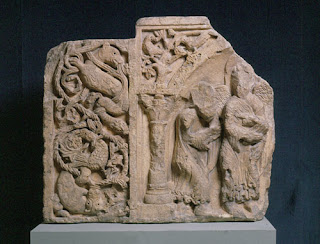
The medieval building of Pécs cathedral was completed during the 12th century. The building, although rebuilt several times, essentially survived until the late 19th century, when it was drastically remodeled ('restored') in Neo-Romanesque style. Directed by the architect Friedrich von Schmidt, this construction took place between 1882-1891. The remodeling brought to light much of the original Romanesque sculptural decoration of the cathedral, the remains of which were all removed from the building, and placed in a lapidarium. The carvings have been moved from one place to another during the last 100 years, until they finally found a home in the newly constructed Cathedral Museum, which opened in 2004. This museum contains the richest collection of Romanesque sculpture in Central Europe - and these sculptures are of extremely high quality. The material includes the narrative cycles from the walls of two stairways leading down to the crypt, fragments of the altar of the Holy Cross and the western portal of the cathedral, among many other carvings. Unfortunately, the beautiful Gothic carvings found among the ruins of chapels north of the cathedral are not on view (for more info, see the
website of the Sigismundus-exhibition).
 |
Romanesque narrative reliefs from Pécs cathedral
Pécs, Cathedral Museum |
No modern catalogue of the material is available - in fact, there is simply no current publication available on this material in any language. There isn't even a small guidebook to the museum, where actually not even all the labels have been properly written. Pécs is a
world heritage site (because of the Early Christian necropolis of the town, located in the area around the cathedral) and was the
European capital of culture during 2010. Still, nothing happened around the cathedral museum. The Cathedral Museum has no
real website, and there is barely any information available on the sculptures online. (
This website has some photos and information in Hungarian.
This website, made for university students, also contains some photographs and a useful bibliography).
 |
Angel
Pécs, Cathedral Museum |
On January 14, 2011, a public workshop will be dedicated to new research on Pécs cathedral, organized by the University of Pécs. At this occasion, the work of a research group established last year and coordinated by Endre Raffay will be presented. You can read the program
here (in Hungarian).
Results of the research of an older generation of scholars - notably Melinda Tóth - remain largely unpublished. Maybe a younger generation of scholars is needed to publish much-needed information and evaluation of Hungary's most important Romanesque monument.











_7.jpg)











